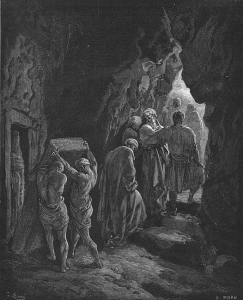Today’s Parashah {פרשה} (weekly Torah portion) is ‘Chayei Sarah’ {חיי שרה} (Hebrew for ‘Life of Sarah’). This is the fifth weekly Torah portion in the Book of Genesis and can be found in Genesis 23:1–25:18.
The name of the weekly Torah portion comes from the second and third words (in the original Hebrew) of the opening verse:
“Sarah lived 127 years; these were the years of the life of Sarah. (Genesis 23:1)
At first glance, it seems that the second part of the verse is quite unnecessary because it does not provide us with any new information. However, when you see it in the original Hebrew, it appears that there are TWO possible ways to understand the last part of the verse. The original Hebrew for the relatively long phrase ‘these were the years of the life of Sarah’ is ‘She’ne Chayei Sarah.’ {שני חיי שרה}

The Hebrew learners among you are probably familiar with the Hebrew word for ‘years’ which is ‘Shanim.’ {שנים} However, in this particular case we encounter a more advanced grammatical Hebrew structure which is called in linguistics ‘status constructus’ (in Latin) or ‘the construct state’ in English (and ‘Semichut’ {סמיכות} in Hebrew).
This grammatical phenomenon is unique to Semitic languages such as Hebrew. It is used in cases where we have TWO nouns occurring one right after one another so that the FIRST noun modifies the second one and is receiving a shorter version.
In other words, the Hebrew word for ‘years’ is ‘Shanim.’ However, when there is another noun immediately afterwards, like in our case, the word ‘Shanim’ will change and appears in its shorter version ‘She’ne.'{שני}
Now, in a rare coincidence (or not…) the shorter version of the Hebrew word ‘Shanim’ – meaning ‘She’ne’ – is also the shorter version of the Hebrew number ‘She’naim’ {שניים} (‘two’).
This means one can understand that phrase as ‘these were the years of the life of Sarah’ as appears in the English translation, or ‘these were the TWO lives of Sarah.’
Logically, the first possibility sounds better and makes more sense. But keep in mind that in Biblical Hebrew, one can find several figures of speech that may very well apply to the second option – and especially in the Book of Genesis – as can be found in the following example:
“When Adam had lived 130 years, he fathered a son in his own likeness, after his image, and named him Seth. The days of Adam after he fathered Seth were 800 years; and he had other sons and daughters. Thus all the days that Adam lived were 930 years, and he died.” (Genesis 5:3-6)
As you can see, the Bible divides the life of Adam (nor only in this case, but also the others) into TWO parts: BEFORE he had children and AFTER he had children.
Moreover, we can understand the verse about Sarah’s life as referring to the life she had BEFORE giving birth to Isaac and then AFTER his birth. Additionally, in this case it makes more sense because the Bible provided us with NEW information – Sarah lived 127 years, IN TOTAL, which includes the two distinct parts of her life.
